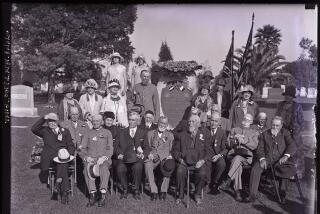Maryland’s Santa Reb and Yankee Claus
- Share via
FREDERICK, Md. — This Santa Claus wears stars and stripes, that one a Confederate uniform. It’s the Civil War, Christmas-style, in a border state where the North-South conflict seems as eternal as Old Saint Nick.
Robert W. Parker, proud descendant of a Confederate veteran, created his rebel Santa suit after seeing another Civil War history buff, Kevin Rawlings, in a costume with a distinctively Union cut several years ago.
Parker stitched together a bright-red version of a Confederate lieutenant general’s coat and started spreading a Southern version of the Santa Claus legend.
“We were brothers separated at birth. He was taken north and I was taken south, and that’s how we can do the whole world in one night,” Parker of Brandywine, Md., tells curious children.
His outfit hardly needs explaining, though, in an area where battle reenactments are as routine as county fairs and passions still simmer over Maryland’s deep wartime division.
A slave state situated below the Mason-Dixon line, Maryland stayed in the Union with some reluctance as federal troops occupied Annapolis, the state capital. Had Maryland seceded, Washington would have been surrounded by Confederate territory.
Given that history, splitting up Santa Claus seems only natural to some.
“It’s kind of appropriate for this area. You couldn’t get much closer to an area where the division actually took place,” Michael Graves said as his daughters Michelle, 11, and Megan, 5, visited with Parker at the National Museum of Civil War Medicine.
Rawlings has played the museum in some of his 11 years as a Civil War Santa. He and Parker, who both sport chest-length beards, occasionally bump into each other during the Christmas season.
“We’re friendly. We haven’t decided to go into the cage of death and duel,” said Rawlings, 44, a Sharpsburg resident and author of a Civil War history book, “We Were Marching on Christmas Day.”
He quibbles with Parker’s costume, though. Rawlings modeled his own star-spangled blue coat and red-and-white striped pants after a Santa Claus drawn by Thomas Nast for the Christmas 1862 issue of Harper’s Weekly magazine. He contends Parker’s outfit lacks authenticity.
“I have done my homework, and there is no documentation for a Confederate Santa Claus,” he said.
The Nast illustration shows Santa dangling a strangled puppet of Confederate President Jefferson Davis before Union troops. It is a clearly partisan image; Parker said Rawlings’ outfit is too.
“In Richmond in 1860, he would not have been very popular,” said Parker, 54, a safety inspector.
He bases his shtick in part on a Louise Clack children’s story, “General Lee and Santa Claus,” published in 1867, two years after the war. The story, aimed at appeasing deprived Southern children, has Lee ordering Santa to sell Christmas toys and buy medical supplies and food for wounded Confederate soldiers.
“Santa is Santa, and Santa loves children, so that part is not political, per se,” Parker said, “but the way he was drawn by Thomas Nast, giving toys and food to the Union troops, there were two different Santas.”
Rawlings, who has worn both blue and gray in battle reenactments, said he is only interested in historical accuracy. Ultimately, he said, the costume is less important than the generous spirit of Santa Claus, whose image has been evolving for centuries.
“When kids ask me how old I am, I say, ‘I’m 1,500 years old, and this is what I happened to pull out of my closet today,’ ” Rawlings said.
More to Read
Sign up for The Wild
We’ll help you find the best places to hike, bike and run, as well as the perfect silent spots for meditation and yoga.
You may occasionally receive promotional content from the Los Angeles Times.





